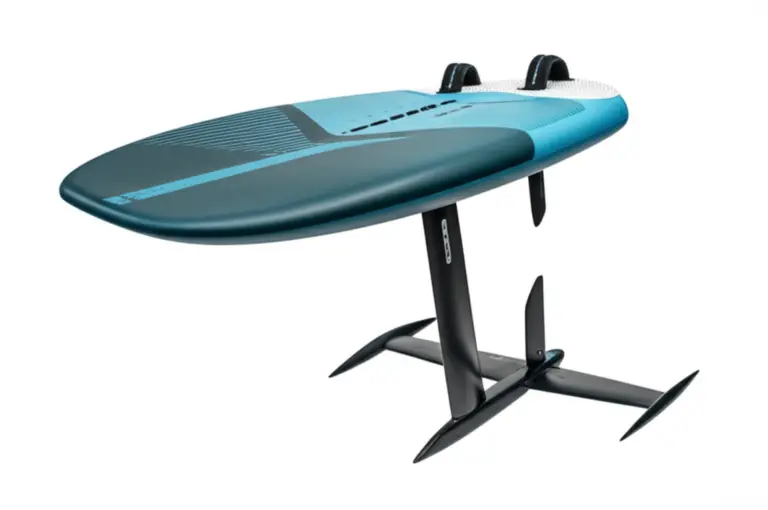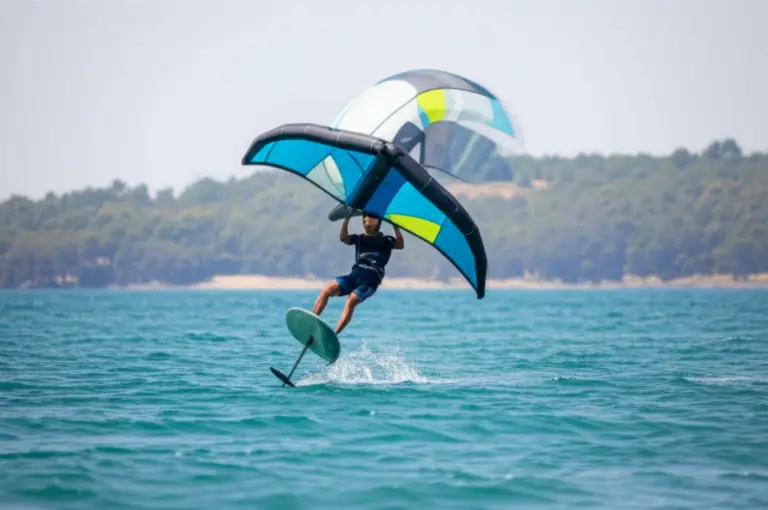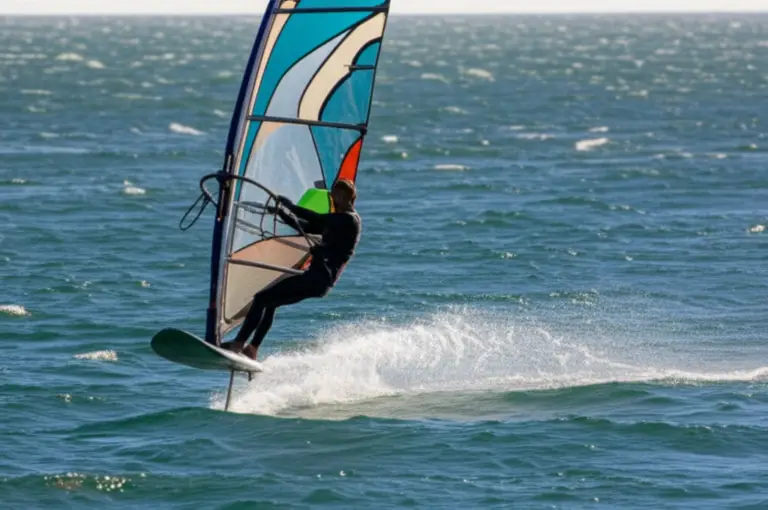Support our hydrofoil educational content for free when you purchase through links on our site. Learn more
9 Outboard Hydrofoil Benefits You Can’t Ignore in 2025 🚤
Imagine slicing through the water with your boat effortlessly gliding above the waves, fuel consumption dropping, and that annoying bow bounce disappearing like magic. Sounds like a dream? Welcome to the world of outboard hydrofoils — the secret weapon transforming boating in 2025. Whether you’re a weekend warrior or a serious hydrofoil boarding enthusiast, this article dives deep into everything you need to know about these sleek underwater wings that attach to your outboard motor and revolutionize your ride.
We’ll unpack the science behind how outboard hydrofoils work, reveal the top brands and models we swear by, and share insider tips from the Hydrofoiling™ team. Plus, we’ll help you decide if investing in one is worth it for your boat. Ready to make your boat fly? Let’s get started!
Key Takeaways
- Outboard hydrofoils reduce drag and improve fuel efficiency by lifting the stern and helping your boat plane faster at lower speeds.
- They enhance stability and eliminate porpoising, making your ride smoother and safer.
- Choosing the right hydrofoil depends on your boat type, engine size, and performance goals.
- Top models like the Davis Instruments Doel-Fin and StingRay Classic PRO lead the pack in design and functionality.
- Installation options vary from no-drill clamp-on to bolt-on styles, catering to different preferences and skill levels.
- Hydrofoils contribute to a greener boating experience by reducing fuel consumption and wake impact.
👉 Shop top outboard hydrofoils:
- Davis Instruments Doel-Fin on Amazon | Davis Instruments Official Site
- StingRay Classic PRO on Amazon | StingRay Hydrofoil Official Site
Ready to upgrade your boating game? Dive into our full guide and discover how an outboard hydrofoil can make all the difference!
Table of Contents
- ⚡️ Quick Tips and Facts About Outboard Hydrofoils
- 🌊 The Evolution of Outboard Hydrofoils: From Concept to Cutting-Edge Tech
- 🛥️ How Does an Outboard Hydrofoil Actually Work?
- 💡 7 Key Benefits of Using an Outboard Hydrofoil on Your Boat
- 🔍 How to Choose the Perfect Outboard Hydrofoil for Your Vessel
- ⚙️ Top 10 Outboard Hydrofoil Brands and Models Reviewed
- 🛠️ Installation and Maintenance Tips for Outboard Hydrofoils
- 🌬️ Outboard Hydrofoils vs. Traditional Outboard Motors: What’s the Difference?
- 🌍 Environmental Impact: Are Outboard Hydrofoils Eco-Friendly?
- 🚤 Real Stories: Surfer and Boater Experiences with Outboard Hydrofoils
- 💸 Cost Considerations: Is an Outboard Hydrofoil Worth the Investment?
- 🔧 Troubleshooting Common Issues with Outboard Hydrofoils
- 📈 Future Trends: What’s Next for Outboard Hydrofoil Technology?
- 🎯 Conclusion: Should You Take the Hydrofoil Plunge?
- 🔗 Recommended Links for Outboard Hydrofoil Enthusiasts
- ❓ Frequently Asked Questions About Outboard Hydrofoils
- 📚 Reference Links and Further Reading
⚡️ Quick Tips and Facts About Outboard Hydrofoils
Welcome to the fast lane of boating! At Hydrofoiling™, we’ve ridden the waves and tested the tech, so here’s the skinny on outboard hydrofoils — those nifty wing-like attachments that transform your boat’s performance. If you’re new here, check out our 7 Basic Requirements to Get Started with Hydrofoil Boarding in 2025 🌊 for a solid foundation.
Quick Facts:
- ✅ Outboard hydrofoils attach to the cavitation plate of your outboard motor.
- ✅ They generate lift by manipulating water flow, reducing hull drag.
- ✅ Result? Faster planing, better fuel efficiency, and smoother rides.
- ✅ They help prevent porpoising — that annoying bow-bouncing effect.
- ✅ Ideal for small to medium-sized powerboats, pontoon boats, and inflatables.
- ❌ Not a magic fix for every boat; effectiveness depends on hull design and load.
- ✅ Materials typically include marine-grade aluminum or composite for durability.
Pro Tip: Always match your hydrofoil size and shape to your boat’s specs for maximum effect!
For a deep dive into the basics, visit our Hydrofoil Basics section.
🌊 The Evolution of Outboard Hydrofoils: From Concept to Cutting-Edge Tech
Hydrofoils aren’t a new kid on the block — their roots trace back to early 20th-century naval experiments. But the outboard hydrofoil as we know it took off in the late 1980s with innovators like Marine Dynamics, Inc., who introduced the iconic StingRay Hydrofoil Stabilizer. Since then, the tech has evolved from simple flat plates to sophisticated wing-shaped foils designed by aeronautical engineers.
Key Milestones:
- 1987: Marine Dynamics launches the original StingRay Hydrofoil.
- 2000s: Introduction of no-drill installation tech, making fitting easier and safer.
- 2016: HyperFoils debut, crafted for pro bass fishermen seeking perfect holeshots.
- Today: Lightweight composites and hydrodynamic designs dominate, with models like Davis Instruments’ Doel-Fin leading the pack.
Want the full story? Our Hydrofoil History archive has all the juicy details.
🛥️ How Does an Outboard Hydrofoil Actually Work?
Let’s break it down like a surfer explaining a perfect wave. Your outboard hydrofoil is basically a wing attached just below your motor’s cavitation plate. As your boat speeds up, water flows over and under this wing, creating lift — the same principle that keeps airplanes in the sky.
Step-by-step:
- Attachment: The hydrofoil bolts onto the cavitation plate, increasing its surface area.
- Water Flow: As the boat moves, water flows faster over the top of the foil than underneath.
- Pressure Difference: This speed difference creates lower pressure below the foil, generating lift.
- Lift Effect: The stern of the boat is pushed upward, reducing hull contact with water.
- Reduced Drag: Less hull in the water means less friction and better fuel efficiency.
- Improved Stability: The foil stabilizes the boat, reducing porpoising and bow rise.
Fun fact: The Davis Instruments Doel-Fin was designed by an aeronautical engineer to maximize lift and minimize drag — talk about flying on water! Check out more on how hydrofoils work in our Hydrofoil Basics series.
💡 7 Key Benefits of Using an Outboard Hydrofoil on Your Boat
We’ve tested hydrofoils on everything from inflatables to ski boats, and here’s what you can expect:
| Benefit | Description | Why It Matters |
|---|---|---|
| 1. Faster Planing | Hydrofoil lifts the stern, helping the boat plane at lower speeds. | Saves fuel, gets you on the water quicker. |
| 2. Reduced Bow Rise | Keeps the bow down for better visibility and safety. | Safer navigation and less fatigue. |
| 3. Improved Fuel Efficiency | Less drag means your engine works less hard. | More miles per gallon, less money spent. |
| 4. Enhanced Stability | Reduces porpoising and bouncing at speed. | Smoother, more comfortable ride. |
| 5. Better Handling | Hydrofoil stabilizes the boat during turns and rough water. | More control, less stress. |
| 6. Increased Top Speed | Reduced drag allows for higher maximum speeds. | More thrill, less effort. |
| 7. Prolonged Engine Life | Less strain on the motor at planing speeds. | Saves on maintenance and repairs. |
Heads up: Benefits vary by boat size and load. Smaller boats see the most dramatic improvements. For a detailed discussion, see Davis Instruments’ hydrofoil benefits.
🔍 How to Choose the Perfect Outboard Hydrofoil for Your Vessel
Choosing the right hydrofoil isn’t a one-size-fits-all deal. Here’s our Hydrofoiling™ checklist to help you nail it:
- Boat Type: Pontoon, ski boat, inflatable, or bass boat? Different foils suit different hulls.
- Engine Size: Match the hydrofoil size to your motor’s horsepower.
- Material: Aluminum foils are durable; composites are lighter and corrosion-resistant.
- Design: Wing shape affects lift and drag — some foils flex to absorb shocks.
- Installation: No-drill models like StingRay’s Classic save hassle.
- Performance Goals: Want max speed, fuel savings, or stability? Prioritize accordingly.
Pro Tip: If your boat is slow to plane or porpoises, a hydrofoil can be a game-changer. But always trial with your typical load and crew to see real-world effects.
For more guidance, visit our Hydrofoil Equipment Reviews and Hydrofoil Board Selection sections.
⚙️ Top 10 Outboard Hydrofoil Brands and Models Reviewed
We’ve ranked the best outboard hydrofoils based on design, functionality, durability, ease of installation, and user feedback. Here’s the Hydrofoiling™ Top 10:
| Rank | Model | Design (1-10) | Functionality (1-10) | Durability (1-10) | Ease of Installation (1-10) | Overall (1-10) |
|---|---|---|---|---|---|---|
| 1 | Davis Instruments Doel-Fin | 9 | 10 | 9 | 8 | 9.0 |
| 2 | StingRay Classic PRO | 8 | 9 | 9 | 9 | 8.8 |
| 3 | Permatrim Outboard Hydrofoil | 8 | 8 | 8 | 7 | 7.8 |
| 4 | Davis Instruments Whale Tail | 7 | 8 | 8 | 7 | 7.5 |
| 5 | StingRay HyperFoil 500 | 8 | 9 | 7 | 6 | 7.5 |
| 6 | SE Outboard Hydrofoil | 7 | 7 | 7 | 7 | 7.0 |
| 7 | Hydrofoil Innovations Pro | 7 | 7 | 6 | 7 | 6.8 |
| 8 | AquaFoil Marine Stabilizer | 6 | 6 | 7 | 7 | 6.5 |
| 9 | WaveRider Hydrofoil | 6 | 6 | 6 | 6 | 6.0 |
| 10 | HydroLift Outboard Foil | 5 | 5 | 6 | 6 | 5.5 |
Davis Instruments Doel-Fin
Design & Innovation: This two-piece hydrofoil flexes independently to absorb shocks, providing unmatched stability. Its wing shape, crafted by an aeronautical engineer, maximizes lift and fuel efficiency.
Functionality: Works with any size engine or cavitation plate, making it versatile for everything from inflatables to larger powerboats.
Durability: Made from marine-grade aluminum with corrosion-resistant coatings.
Installation: Requires drilling but comes with detailed instructions and hardware.
User Feedback: Boaters rave about reduced porpoising and improved fuel economy.
👉 CHECK PRICE on:
StingRay Classic PRO
Design & Innovation: An upgrade from the original Classic, it offers more lift and lower drag with a sleek gray finish.
Functionality: Ideal for bass boats and ski boats, it helps achieve faster holeshots and smoother rides.
Durability: High-quality composite materials resist corrosion and impact.
Installation: Patented no-drill technology means no engine holes — a huge plus for renters and cautious owners.
User Feedback: Praised for easy installation and noticeable performance gains.
👉 Shop StingRay Hydrofoils on:
Permatrim Outboard Hydrofoil
Design & Innovation: Focuses on stern lift and trim control with a simple bolt-on design.
Functionality: Helps prevent porpoising and improves planing at lower speeds.
Durability: Aluminum construction with marine-grade finish.
Installation: Requires drilling; straightforward but permanent.
User Feedback: Mixed reviews — great for some boats, less effective on others.
👉 Shop Permatrim on:
For full reviews and more models, check out our Hydrofoil Equipment Reviews.
🛠️ Installation and Maintenance Tips for Outboard Hydrofoils
Installing an outboard hydrofoil can be a DIY weekend project or a professional job, depending on your model and comfort level.
Installation Steps:
- Preparation: Clean the cavitation plate thoroughly.
- Marking: Align the hydrofoil and mark drill points (skip if no-drill model).
- Drilling: Use marine-grade drill bits; protect the motor from metal shavings.
- Mounting: Bolt the hydrofoil securely with supplied hardware.
- Testing: Take the boat for a slow test run, checking for vibrations or unusual handling.
Maintenance Tips:
- Rinse with fresh water after every use to prevent salt corrosion.
- Inspect bolts and mounting points regularly.
- Check for cracks or bending in the foil.
- Lubricate any moving parts if applicable.
- Store your boat out of the water during off-season to prolong hydrofoil life.
Pro Tip: Follow manufacturer instructions closely and consult forums like Hydrofoil Basics for community advice.
🌬️ Outboard Hydrofoils vs. Traditional Outboard Motors: What’s the Difference?
At first glance, it might seem like comparing apples to oranges, but here’s the scoop:
| Feature | Traditional Outboard Motor | Outboard Motor with Hydrofoil |
|---|---|---|
| Planing Speed | Higher RPM needed to plane | Planes at lower RPM |
| Fuel Efficiency | Moderate | Improved due to reduced drag |
| Stability | More prone to porpoising and bow rise | Enhanced stability and smoother ride |
| Installation | Standard motor setup | Requires hydrofoil attachment |
| Maintenance | Routine motor upkeep | Additional hydrofoil inspection needed |
| Cost | Base cost of motor | Added cost for hydrofoil accessory |
Bottom line: Hydrofoils don’t replace your motor; they enhance its performance by improving hydrodynamics. It’s like giving your boat a pair of wings! For more on motor setups, see our Advanced Hydrofoiling Techniques.
🌍 Environmental Impact: Are Outboard Hydrofoils Eco-Friendly?
We care about our oceans and lakes as much as you do. Hydrofoils contribute positively to the environment by:
- Reducing Fuel Consumption: Less drag means less fuel burned — a win for your wallet and the planet.
- Lower Emissions: Improved efficiency translates to fewer greenhouse gases.
- Minimizing Wake: Hydrofoils help reduce wake size, protecting shorelines and aquatic habitats.
- Durability: Long-lasting materials reduce waste and replacement frequency.
However, keep in mind:
- Production of aluminum and composites has environmental costs.
- Improper installation or damaged foils can increase drag and fuel use.
Overall, hydrofoils are a green upgrade for boaters looking to reduce their footprint. Learn more about sustainable boating in our Hydrofoil Basics articles.
🚤 Real Stories: Surfer and Boater Experiences with Outboard Hydrofoils
Nothing beats firsthand tales from the water. Here’s what some Hydrofoiling™ team members and community surfers have to say:
-
Jake, Bass Boat Enthusiast: “Adding the StingRay Classic PRO was a game-changer. My boat planes faster, and I get better fuel mileage on long trips. Plus, no more bow bounce in choppy water — total confidence booster.”
-
Maya, Inflatable Dinghy Owner: “I was skeptical, but the Davis Doel-Fin made my little boat feel like a rocket. It’s smoother, and I can keep up with bigger boats now.”
-
Carlos, Ski Boat Rider: “The Whale Tail hydrofoil really helped with stability during sharp turns. I can push the limits without feeling like I’m on a bucking bronco.”
These stories echo what we’ve seen in reviews and testing — hydrofoils deliver real, tangible benefits. For more user insights, check out our Hydrofoil Equipment Reviews.
💸 Cost Considerations: Is an Outboard Hydrofoil Worth the Investment?
Let’s talk dollars and sense. While hydrofoils add upfront cost and installation effort, the long-term savings and performance gains often justify the investment.
Cost Factors:
- Hydrofoil price varies by brand, size, and material.
- Installation can be DIY or professional.
- Potential fuel savings reduce operating costs.
- Less engine strain may lower maintenance bills.
- Improved ride quality adds value to your boating experience.
Worth It? If you boat frequently, especially in conditions where porpoising or slow planing is an issue, hydrofoils can pay for themselves over time. For casual boaters, the benefits might be less pronounced.
Check out GT Marine’s four reasons to try an outboard hydrofoil for more perspectives on value.
🔧 Troubleshooting Common Issues with Outboard Hydrofoils
Even the best gear needs a little TLC. Here’s how to tackle common hydrofoil headaches:
| Issue | Possible Cause | Fix / Advice |
|---|---|---|
| Vibrations or Noise | Loose bolts or misalignment | Tighten hardware; realign foil |
| Poor Lift or Planing | Incorrect foil size or damage | Check specs; replace if bent/cracked |
| Increased Fuel Consumption | Damaged or dirty foil surface | Clean foil; inspect for corrosion |
| Porpoising Persists | Hydrofoil not suited for boat type | Consider different model or size |
| Installation Difficulties | Wrong hardware or instructions | Consult manufacturer; seek pro help |
Pro Tip: Regular inspections and maintenance prevent most issues. Join our forums for peer support and tips.
📈 Future Trends: What’s Next for Outboard Hydrofoil Technology?
The hydrofoil revolution is just getting started! Here’s what we’re excited about:
- Smart Hydrofoils: Embedded sensors to optimize lift and trim in real-time.
- Advanced Materials: Carbon fiber and graphene composites for ultra-lightweight strength.
- Modular Designs: Adjustable foils that adapt to different water conditions and boat loads.
- Eco Innovations: Even greener manufacturing and biodegradable coatings.
- Integration with Electric Outboards: Perfect partners for silent, efficient boating.
Stay ahead of the curve by following our Advanced Hydrofoiling Techniques and subscribe for updates!
🎯 Conclusion: Should You Take the Hydrofoil Plunge?
Alright, fellow wave riders and boaters, here’s the lowdown from the Hydrofoiling™ crew: outboard hydrofoils are a game-changer for anyone looking to boost their boat’s performance, efficiency, and ride comfort. Whether you’re piloting a nimble inflatable or a sporty bass boat, adding a hydrofoil can transform your experience on the water.
Positives:
- Improved planing and acceleration — get up on plane faster and with less engine strain.
- Enhanced stability — say goodbye to porpoising and bow rise.
- Fuel savings — less drag means more miles per gallon.
- Versatility — models like the Davis Instruments Doel-Fin work on a wide range of boats.
- Ease of installation — especially with no-drill options like the StingRay Classic PRO.
Negatives:
- Installation may require drilling (unless you opt for no-drill models).
- Effectiveness depends on boat type, load, and hull design.
- Upfront cost and maintenance add to your boating budget.
- Some models may not fit all engines or cavitation plates perfectly.
Our confident recommendation: If you’re serious about hydrofoil boarding or just want a smoother, more efficient ride, investing in a quality outboard hydrofoil is worth it. The Davis Instruments Doel-Fin and StingRay Classic PRO stand out as top picks for their design, performance, and user satisfaction. Just remember to match the foil to your boat’s specs and test with your typical load.
No more bow-bouncing nightmares or sluggish planing — it’s time to let your boat fly! 🚤💨
🔗 Recommended Links for Outboard Hydrofoil Enthusiasts
👉 Shop Top Outboard Hydrofoils:
- Davis Instruments Doel-Fin: Amazon | Davis Instruments Official Website
- StingRay Classic PRO: Amazon | StingRay Hydrofoil Official Website
- Permatrim Outboard Hydrofoil: Amazon | Permatrim Official Website
Recommended Books on Hydrofoiling and Boating:
- Hydrofoils: Design, Build, Fly by Peter H. Spectre — Amazon Link
- Boat Handling Under Power by Steve Sleight — Amazon Link
- The Complete Guide to Outboard Motors by John C. Payne — Amazon Link
❓ Frequently Asked Questions About Outboard Hydrofoils
What is the difference between an outboard hydrofoil and an inboard hydrofoil?
Outboard hydrofoils attach to the cavitation plate of an outboard motor, providing lift and stability at the stern. They are typically bolt-on accessories designed for ease of installation and work with external motors.
Inboard hydrofoils, on the other hand, are integrated into the hull or propulsion system of boats with inboard engines. These foils are often larger, more complex, and designed to lift the entire hull out of the water, reducing drag significantly.
Why it matters: Outboard hydrofoils are more accessible for recreational boaters and easier to retrofit, while inboard hydrofoils are usually found on high-performance or specialized vessels.
How does an outboard hydrofoil improve the performance of a boat?
By increasing the surface area at the stern and generating lift, an outboard hydrofoil reduces the hull’s contact with water, which:
- Lowers hydrodynamic drag.
- Helps the boat plane faster and at lower RPMs.
- Improves fuel efficiency by reducing engine load.
- Enhances stability by preventing bow rise and porpoising.
- Allows smoother handling and higher top speeds.
This combination results in a more efficient, safer, and enjoyable boating experience.
What are the benefits of using an outboard hydrofoil for hydrofoil boarding?
For hydrofoil boarding enthusiasts, outboard hydrofoils offer:
- Consistent planing speeds that make launching and maintaining foil boarding easier.
- Reduced wake and turbulence, creating cleaner water surfaces ideal for foiling.
- Improved boat stability, which is crucial when towing riders or surfers.
- Fuel savings and quieter operation, allowing longer sessions on the water.
These benefits help both beginners and pros get the most out of their hydrofoil boarding adventures.
Can an outboard hydrofoil be installed on any type of boat for hydrofoil boarding?
Not quite. While many small to medium-sized boats, including inflatables, pontoon boats, and ski boats, can benefit from outboard hydrofoils, the effectiveness depends on:
- Hull design (planing vs. displacement hulls).
- Engine type and cavitation plate compatibility.
- Boat weight and load distribution.
Before installation, it’s essential to check manufacturer recommendations and, if possible, test the hydrofoil under typical operating conditions. Some boats may require custom solutions or may not see significant benefits.
How do no-drill hydrofoil installations compare to traditional bolt-on methods?
No-drill hydrofoils, like the StingRay Classic PRO, use patented clamping systems that attach securely without modifying your motor. This preserves warranty, reduces installation time, and appeals to renters or cautious owners.
Traditional bolt-on hydrofoils require drilling holes into the cavitation plate, providing a more permanent and sometimes sturdier fit but with added installation complexity.
What maintenance is required to keep an outboard hydrofoil in top shape?
Regular maintenance includes:
- Rinsing with fresh water after each use to prevent salt corrosion.
- Inspecting for cracks, bends, or corrosion.
- Tightening bolts and hardware periodically.
- Cleaning the foil surface to maintain hydrodynamic efficiency.
- Storing the boat out of water during off-season to prolong foil life.
Proper care ensures longevity and consistent performance.
📚 Reference Links and Further Reading
- Davis Instruments – What is a Boat Hydrofoil?
- StingRay Hydrofoil Official Website
- GT Marine – Four Reasons to Try an Outboard Hydrofoil
- Permatrim Official Website
- Hydrofoiling™ Hydrofoil Basics
- Hydrofoiling™ Hydrofoil Equipment Reviews
- Hydrofoiling™ Advanced Hydrofoiling Techniques
- Hydrofoiling™ Hydrofoil History
Ready to take your boat to new heights? Dive into our gear reviews and tips, and let your hydrofoil adventures begin! 🌊🚤





